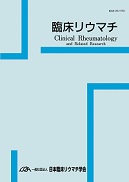Volume 27, Issue 3
Clinical Rheumatology and Related Research
Displaying 1-12 of 12 articles from this issue
- |<
- <
- 1
- >
- >|
editor's eye
-
2015Volume 27Issue 3 Pages 155-156
Published: September 30, 2015
Released on J-STAGE: November 30, 2015
Download PDF (252K)
journal article
-
2015Volume 27Issue 3 Pages 157-161
Published: September 30, 2015
Released on J-STAGE: November 30, 2015
Download PDF (759K)
review article
-
2015Volume 27Issue 3 Pages 163-170
Published: September 30, 2015
Released on J-STAGE: November 30, 2015
Download PDF (531K)
original article
-
2015Volume 27Issue 3 Pages 171-177
Published: September 30, 2015
Released on J-STAGE: November 30, 2015
Download PDF (427K) -
2015Volume 27Issue 3 Pages 178-183
Published: September 30, 2015
Released on J-STAGE: November 30, 2015
Download PDF (425K) -
2015Volume 27Issue 3 Pages 184-188
Published: September 30, 2015
Released on J-STAGE: November 30, 2015
Download PDF (851K) -
2015Volume 27Issue 3 Pages 189-197
Published: September 30, 2015
Released on J-STAGE: November 30, 2015
Download PDF (524K) -
2015Volume 27Issue 3 Pages 198-204
Published: September 30, 2015
Released on J-STAGE: November 30, 2015
Download PDF (1145K) -
2015Volume 27Issue 3 Pages 205-211
Published: September 30, 2015
Released on J-STAGE: November 30, 2015
Download PDF (422K) -
2015Volume 27Issue 3 Pages 212-218
Published: September 30, 2015
Released on J-STAGE: November 30, 2015
Download PDF (664K) -
2015Volume 27Issue 3 Pages 219-226
Published: September 30, 2015
Released on J-STAGE: November 30, 2015
Download PDF (677K)
Basic Medicine for Rheumatologist
-
2015Volume 27Issue 3 Pages 228-231
Published: September 30, 2015
Released on J-STAGE: November 30, 2015
Download PDF (379K)
- |<
- <
- 1
- >
- >|
